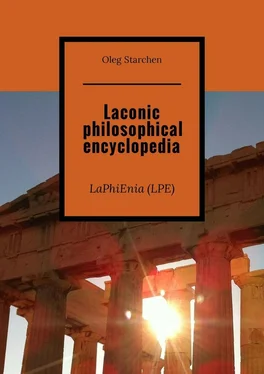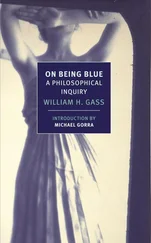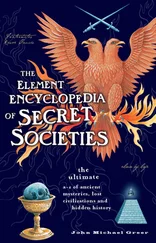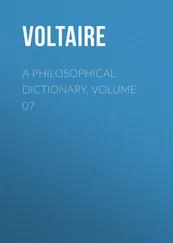Laconic philosophical encyclopedia
LaPhiEnia (LPE)
Oleg Starchen
© Oleg Starchen, 2018
ISBN 978-5-4493-2410-8
Created with Ridero smart publishing system
(I am not very well know English, so, I apologies for mistakes.) This encyclopedia is about the love of wisdom, and it is laconic, which is defined by its name. This “encyclopedia” is such not in the academic sense, but in the Hegel sense, because the great philosopher Georg Hegel created the original work “Encyclopedia of philosophical Sciences”. Therefore, a LAconic PHIlosophical ENcyclopedIA, or, for short, i.e., speaking laconically, LaPhiEnia (LPE) is also the ORiginal PHIlosophical ENcyclopedIA, OrPhiEnia.
© Oleg Starchen, 2018
First publishing in Ridero: 07.03.2018 © Oleg Starchen Translators: Yandex.Translator and Oleg Starchen
DEDICATED
to my historical friend,
to congenial but different,
to wise but mad,
to silent but evil,
to proolegoman’s philosopher,
to superman’s thinker,
as he himself said and considered himself, to “pole”
Wilhelm Nietzsche
and also to my big sister named Irene.
This encyclopedia is about the love of wisdom, and it is laconic, which is defined by its name. This “encyclopedia” is such not in the academic sense, but in the Hegel sense, because the great philosopher Georg Hegel created the original work “Encyclopedia of philosophical sciences”. Therefore, a LAconic PHIlosophical ENcyclopedIA, or, for short, i.e., speaking laconically, LaPhiEnia is also the Original philosophical encyclopedia, OrPhiEnia. This encyclopedia is called as encyclopedia in the literal and obsolete, i.e. in historical terms, in ancient Greek, this word means “learning in a full sphere”, i.e., as far as possible within the framework of laconicism, the full sphere of learning. This is the third edition of the LPE, in contrast to the first edition of 2012 (on Proza.ru) and from the second edition on June 5, 2018 (on Ridero). This revised and supplemented, corrected and better edition, but quantity remains by definition the same – 300 laconic i.e. sore and gained ideas. Laconic encyclopedia means dictionary, because the verbose dictionary means encyclopedia. And it’s not a simple philosophical dictionary, but the first orgaosophical and zeazrosophical dictionary. The articles in this dictionary or this encyclopedia represent aphorisms, laconisms, i.e. a concise definition of neologisms and neodilogisms (i.e., the dual neologisms, new combinations of two words). Diligence of the author was in the possible greater originality of the themes (because on the website of the Proza.ru, where it was first published this book in 2012, is the symbol © as a formal attribute of each production), so LPE is almost useless for those wishing to study the history of philosophy (although in LPE are articles that show original retrospective on the history of philosophy), but LPE is very useful, i.e. cognitive, to explore the latest trends and the future of philosophy, philosophy of the XXI century ad. Topics of LPE, in most cases, are neothemes, checked for originality to the most important Internet search engines. The explanation of these neothemes is based on the philosophy of supermind, i.e. Zeazrosophy, in that the core rod and the trend of LPE. In the first edition, articles of LPE were not arranged in a systematic manner, which was defined by the Hegelian and historical meaning of the encyclopedia, as well as its originality, its style – the stream of consciousness, the free arrangement of thoughts, as they could be invented and published, but in this edition the vocables are arranged in alphabetical order, which is more consistent with the genre of the encyclopedia or dictionary. LPE is the most concise manifestation of philosophy of Starchen as a philosophical movement. More verbose about topics of Laphienia, by the author’s point of view, is in my manuscripts, but to publish this would be too long, difficult and uninteresting. The number of articles in the LPE is several hundred, but according to laconicism to read this encyclopedia can be fast and interesting.
This is edition 3.1, because this edition is translated on the English language. In this regard I express my thanksgivings to sites translate.yandex.ru and translate.google.com.
Edition 3.2 must be on Ridero etc.
This is edition 3 because i have added illustrations and some text betterments to this edition. In this regard, i express my thanksgivings to the site Pixabay.com (for beautiful illustrations) and sites Litres Samizdat.
Neothreelogism Laconic philosophical encyclopedia first published 20 December 2011 © Oleg Starchen.
The first edition of the LPE published:
November 15, 2012 © Oleg Starchen. (edition 1.0, text)
Second edition of the LPE published:
5 June 2018 © Oleg Starchen. (edition 2.0, text)
Third edition of the LPE published:
3 July 2018 © Oleg Starchen. (edition 3.0, text), with illustrations.
Translation of Third edition of the LPE published on Stihi.ru:
1 august 2018 © Oleg Starchen (edition 3.1, text)
Translation of Third edition of the LPE published on Ridero.ru:
2 august 2018 © Oleg Starchen (edition 3.2, text), with illustrations.
Author of the Laphienia understands that the first, second and even third edition of this book devoted to such a complex and multifaceted science, as philosophy, can not be free from shortcomings and mistakes. All comments and suggestions, as on the system of the Laphienia, and on the content of individual articles, as well as indications of possible inaccuracies would be accepted with thanksgivings.
Socratic reductions, some of which are specific only to Laphienia:
ad – our era, ath. – philosophical era,
see – see or see with respect,
i.e. – that is,
old-gr. – see vocable old-gr. philosophical terminology,
lat. – Latin or Latvian,
etc. – and so forth.
Vocables are arranged in alphabetical order without taking into vocables “THE” article, but if vocable is very important, then the article “THE” is in vocable, thus the most important from my point of view vocables are in the chapter “T” of encyclopedia, the rest vocables consists article “the” of the lower case letters.
1 the AUTOBIOGRAPHICAL PHILOSOPHY
Philosophers often philosophized based on their biography. For example, Nietzsche (or Nieche) even wrote a whole philosophical autobiography “Ecce homo. How they become themselves.”
2 the AMBER OF PHILOSOPHY
The illustration of the philosophical amber – the real amber. Indeed, it looks like a philosopher’s stone.
Laconic aphorisms is amber of philosophy (etymology of the term amber or the “yantar” – dziñtars, by lat.), philosophy, like the psychological resin of the brain, which heals it from psychological trauma, from mental suffering and from silliness, flows from the soul in philosophy, in writing of literature about the love of wisdom, freezes, petrifies and is immortalized in laconisms. Therefore, the philosophical amber – it is the most notorious “philosopher’s stone”.
3 the ACOUSTICS OF PHILOSOPHY
True philosophy is so loud that its roar has been spreading across the planet for millennia. Phonics philosophy is powerful. And even if this includes the proverb “empty barrel sounds louder”, it is not a simple barrel, but the famous barrel of the great cynic Diogenes.
Even Kant in the “Critique of pure reason” argued that alien beings will have other a priori forms of knowledge than a human. This means that they will necessarily have the functions of the super-consciousness, and their own special, alien philosophy.
Читать дальше












